“America the Beautiful”
Essay by Dr. Bryan Zygmont
Katherine Lee Bates was an English professor at Wellesley College in 1893 when she traveled by train to Colorado College to teach a summer course. This form of leisurely travel allowed her the opportunity to see parts of the United States that she had not seen in her first 33 years, most of which had been spent in Massachusetts, the state of her birth. When she finally arrived at the Antler’s Hotel in Colorado Springs, she composed the poem for which she is most famous. It was first published in 1895 as “Pikes Peak,” but in subsequent revisions—first in 1904 and then again in 1911—Bates changed the title to what it is still known by today: American the Beautiful.

Mississippi watershed, created by Horace Mitchell, Lead Visualizer, NASA Visualization Studio
Mississippi watershed, created by Horace Mitchell, Lead Visualizer, NASA Visualization Studio
Most Americans know the first stanza of this poem, and it is possible that as many are unaware that three additional stanzas exist. The poem is a kind of encomium to the vastness of the United States and to its beauty, both natural and that which was manmade. In the 1911 version, the first stanza concludes with the now-famous line, “From sea to shining sea!” What most Americans might take for granted is how vast from sea to shining sea really is. Indeed, the landmass of the contiguous United States—excluding Alaska and Hawaii—is in excess of 3.1 million square miles. To frame this in another way, the mainland of the United States is roughly equal to that of Western Europe from the Atlantic seaboard to Poland.
A vast and varied continent
The vastness of the United States of American has been of continual interest to American painters and photographers. Certainly, if America had anything in excess, it was land. But it is not only the enormity of the United States that artists have commented. They have also made note of the stunning natural beauty of the land, the rise of the urban landscape, and the ways in which the later has, in time, consumed the former. To be sure, an examination of the depiction of the geography and the environment of the United States is an exploration of the history of the United States itself.
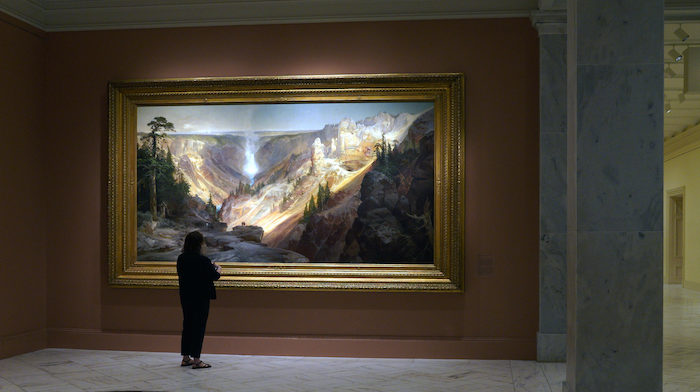
Thomas Moran, Grand Canyon of the Yellowstone, 1872, oil on canvas mounted on aluminum, 213 x 266.3 cm (Smithsonian American Art Museum, Lent by the Department of the Interior Museum, L.1968.84.1)
Thomas Moran, Grand Canyon of the Yellowstone, 1872, oil on canvas mounted on aluminum, 213 x 266.3 cm (Smithsonian American Art Museum, Lent by the Department of the Interior Museum, L.1968.84.1)
We might begin this exploration by examining and comparing two different landscapes: Thomas Moran’s The Grand Canyon of the Yellowstone (1872) and Joseph Stella’s The Voice of the City of New York Interpreted (1920-22). Separated by exactly 50 years, these two paintings might at first seem to be polar opposites. Although the paintings are similar in scale—Stella’s multi-panel Voice of the City measures a majestic 22.5’ x 8.3’ while Moran’s Yellowstone is a not inconsiderable 7’ x 12’—the two artists viewed the land in different ways and with different goals. In the years following the American Civil War, Moran chose to bring attention to the beauty of the American West. In the years following the Great War, Stella aspired to bring attention to the beauty and modernity of the modern American city.
Thomas Moran stands at the forefront of American landscape painters active during the second half of the nineteenth century, and like Frederic Edwin Church before him, Moran was keenly interested in providing his largely east-coast audience with exciting pictures of the far-off American West. In 1871, the director or the United States Geological Survey, Ferdinand Hayden, invited Moran to join an expedition whose goal was to explore and document the Yellowstone region of what is now Wyoming. Moran was joined by a photographer, William Henry Jackson, and together they visually documented an area that would have seemed almost alien to the people living on the eastern seaboard at the time. Jackson took the photographs, Moran extensively sketched, and those provided the basis for the enormous painting Moran completed in his Washington, D.C. studio the following year.
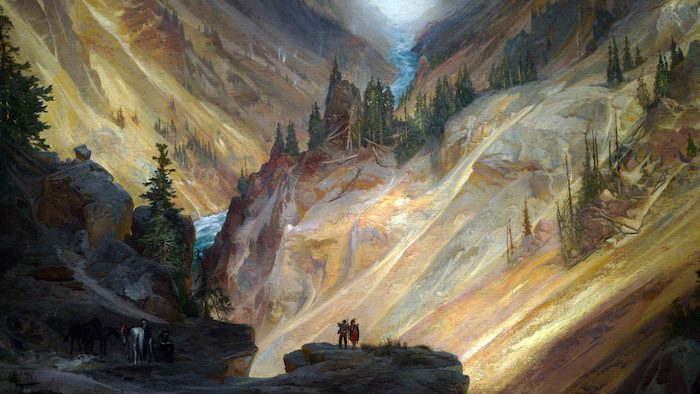
Thomas Moran, Grand Canyon of the Yellowstone (detail), 1872, oil on canvas mounted on aluminum, 213 x 266.3 cm (Smithsonian American Art Museum, Lent by the Department of the Interior Museum, L.1968.84.1)
Thomas Moran, Grand Canyon of the Yellowstone (detail), 1872, oil on canvas mounted on aluminum, 213 x 266.3 cm (Smithsonian American Art Museum, Lent by the Department of the Interior Museum, L.1968.84.1)
And what a majestic view Moran provided for his east coast viewers! It is important to note, however, that although the artist has created each individual part with a kind of naturalistic and scientific precision—that is, geological forms and flora are easily identifiable—Moran was not interested in depicting an accurate rending of what Yellowstone looks like from a particular vantage point. Moran’s Yellowstone is at best a kind of composite view of the landscape, and one might suggest the painter was more interested in creating a kind of truth in regards to the experience of viewing Yellowstone than in accurately rendering what it is that he saw while there. Although there is a small human presence—two figures face away from the view on the precipice in the foreground and three others can be seen to their left—this is a composition that is dominated by the resplendent view, a uniquely American nature. Like many of the landscapists who came before him—Thomas Cole, Asher B. Durand, and Church—Moran has imbued the landscape with a spiritual, almost heavenly quality. Clearly, if nature were his religion, one might call Yellowstone Moran’s cathedral.
Long-lasting effects
Little did Moran know the long-lasting effect his participation in Hayden’s expedition would have. At the conclusion of this adventure, Hayden submitted his document, Preliminary Report on the United States Geological Survey of Montana and Portions of Adjacent Territories; Being a Fifth Annual Report of Progress, to the United States Congress. He augmented his report with Jackson’s magnificent photography and Moran’s sketches and paintings that visually that captured what Hayden’s words could not. Hayden’s plan was a success. Yellowstone became the first National Park on 1 March 1872 when President Ulysses S. Grant signed into the law “An Act to set apart a certain Tract of Land lying near the Head-waters of the Yellowstone River as a public Park.”
If Moran’s painting shows an American monument from the natural world, then, Joseph Stella’s colossal The Voice of the City of New York Interpreted (1920-22) depicts a man-made monument to America. And like Moran’s earlier work, there is a both an implicit and explicitly spiritual quality to Stella’s visual encomium to New York City, his adoptive home. Joseph Stella was born in Muro Lucano Italy, southeast of Naples. He emigrated to New York City in 1896 at the age of 18 and shortly thereafter abandoned his previous aspiration to study medicine and instead attended the Art Students League, studying under William Merritt Chase. Stella returned to Italy in 1909 and over the next four years—that is, until his return to New York City in 1913—he saw and absorbed the Modernist styles then flourishing across Europe. The year of his return coincided with the Armory Show, the now famous exhibition in New York City that introduced America to the modernist art Stella had seen while in Italy and France.
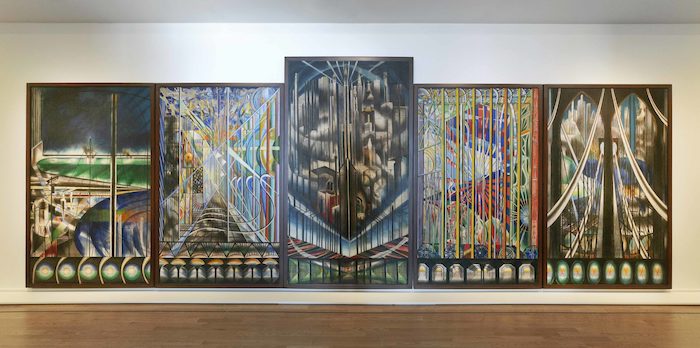
Joseph Stella, The Voice of the City of New York Interpreted, 1920-22, oil and tempera on canvas (five panels), 99.75 x 270 inches overall (Purchase 1937 Felix Fuld Bequest Fund 37.288a-e, Newark Museum of Art)
Joseph Stella, The Voice of the City of New York Interpreted, 1920-22, oil and tempera on canvas (five panels), 99.75 x 270 inches overall (Purchase 1937 Felix Fuld Bequest Fund 37.288a-e, Newark Museum of Art)
The paintings Stella completed after his return show the strong influence of the Italian Futurists he saw in Europe, and New York Interpreted is very much his magnum opus in this vein. The horizontal, multi-panel composition has the form of a Renaissance altarpiece—van Eyck’s masterpiece, the Ghent Altarpiece comes to mind—and this gives Stella’s painting a slight whisper of religious reverence. However, whereas the early Renaissance Flemish master painted a religious scene with a profound sense of naturalistic precision, Stella has instead shown a modern, industrial, and manmade scene while embracing an abstraction that only reveals the underlying architectural forms after some concerted effort by the viewer. Jesus and Mary have been replaced by skyscrapers and bridges.
Confusion of light and sounds
Although this polyptych does not necessarily contain a narrative, it is natural that the viewer observe it from left to right. The leftmost panel shows the Port of New York by night. The strong geometric lines that crisscross the panel provide a sense of power and energy to the composition, but the desaturated and muted blues of the nighttime sky tempers the view. During the day this would be bursting with human activity, a vibrancy that has left with the setting sun. That vibrancy is clearly to be found in the second panel, commonly called The White Way. This is a view of Broadway, which, by the 1920s, was an area filled with energy, verve, and human bustle. The muted colors of the first panel have been replaced with charged reds, high-energy oranges, and loaded yellows. The diagonal lines lead us into the deep spaces of the composition to reveal an almost heavenly depiction of the electric lights for which Broadway was—and still is—so famous. The curvilinear lines and the breathtaking use of color visually render the panoply of sounds that surround Manhattan. When writing of this panel, Stella explained, “Here are sensations produced by the confusion of light and sounds as one emerges from subterranean passages to the street above.” Indeed, the artist seemingly provides a view of the city from multiple perspectives: from below, from above, and from a distance.
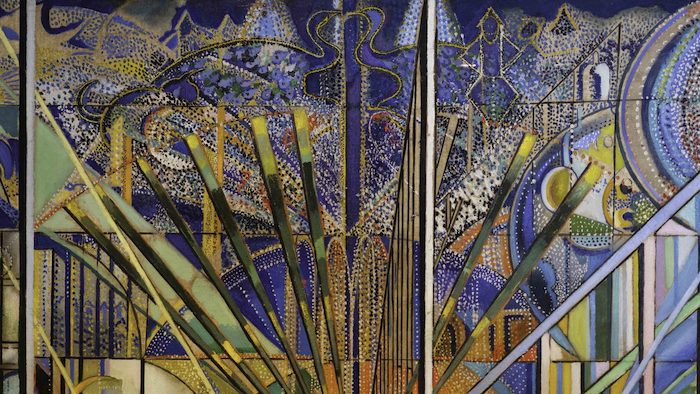
Joseph Stella, The Voice of the City of New York Interpreted (detail of the The White Way), 1920-22, oil and tempera on canvas (five panels), 99.75 x 270 inches overall (Purchase 1937 Felix Fuld Bequest Fund 37.288a-e, Newark Museum of Art)
Joseph Stella, The Voice of the City of New York Interpreted (detail of the The White Way), 1920-22, oil and tempera on canvas (five panels), 99.75 x 270 inches overall (Purchase 1937 Felix Fuld Bequest Fund 37.288a-e, Newark Museum of Art)
If the central panel of the Ghent Altarpiece depicts an enthroned God the Father, then the central panel of this secular polyptych contains the deity of early-twentieth-century urban life: that of the towering skyscraper. The 22-story Flatiron Building (1902) is easily recognizable in the lower center, and yet it is dwarfed by the soaring architecture framed behind it. The shape of the Flatiron building resembles the prow of a ship, and with this as a context, we are either moving towards it, or this mass of industry and technology is moving towards us as viewers. The buildings themselves are not just tall, they serve as reminders as to the technological advances of the twentieth century. We see smokestacks and gas towers, necessary beacons of modern urban life.
The fourth panel mirrors the second; it shows a depiction of Broadway. The color palette within this panel is bright and vibrant; pops of red, blue, yellow, and green draw the attention of our eyes, and descending vertical lines clearly contain musical notes. These small visual references reiterate the idea that the city is alive with the sound of music. Like the other panels, architectural structure is present. Just above the lowermost register we can see a number of small circles that Stella has filled with a kaleidoscopic mix of colors. These appear as whispered references to the stained-glass rose windows so prevalent in gothic cathedrals.
But if the color-filled circles in the fourth panel softly speak to medieval churches, then the pair of lancet arches in the fifth and final panel do not whisper “religion,” they wail it. The structure that it represents is one that is recognizable to every New Yorker; it is the Brooklyn Bridge. First opened in 1883, this connection crossing the East River was in 1920—and remains so today—one of defining architectural structures of The City That Never Sleeps. But if Notre Dame is a monument to God in glass and stone, then the Brooklyn Bridge is a monument to modernity, engineering, and life in steel.
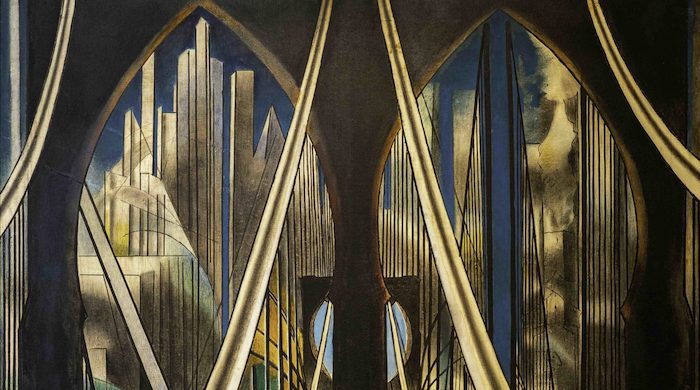
Joseph Stella, The Voice of the City of New York Interpreted (detail of Brooklyn Bridge), 1920-22, oil and tempera on canvas (five panels), 99.75 x 270 inches overall (Purchase 1937 Felix Fuld Bequest Fund 37.288a-e, Newark Museum), a Seeing America video
Joseph Stella, The Voice of the City of New York Interpreted (detail of Brooklyn Bridge), 1920-22, oil and tempera on canvas (five panels), 99.75 x 270 inches overall (Purchase 1937 Felix Fuld Bequest Fund 37.288a-e, Newark Museum), a Seeing America video
When viewed as a whole, The Voice of the City of New York Interpreted eloquently speaks to Stella’s belief that there was something religious—something divine, sacred, and transcendent—about the vibrancy and vitality of the modern American city. And in the same vein, The Grand Canyon of the Yellowstone similarly testifies to the Moran’s belief that there was something religious—divine, sacred, and transcendent—about the beauty of the American landscape. In this way, these two paintings—one nearly photographic in its scientific precision and the second, an excellent example of twentieth-century abstraction—have much in common, but they also indicate the shift that occurred in the United States when it became an industrialized and modern nation.
Suburban desert
If Moran painted nature in Yellowstone and if Stella painted the city in New York Interpreted, then in Fenetre, Eastlake Greens, San Diego (2001), Stéphane Couturier shows the abrupt collision between the two. At first glance, the color palette might suggest that Couturier’s work is a painting, but it is instead a stunningly exposed photograph. Yet despite the photographic medium, the artist has utilized a painterly framing device. Utilizing an open window as an internal frame for a landscape or portrait has a long tradition in Western art. Gabriel Mesu’s A Woman Seated at a Window and Henri Matisse’s Open Window, Collioure, are excellent examples of the open window as a framing mechanism.
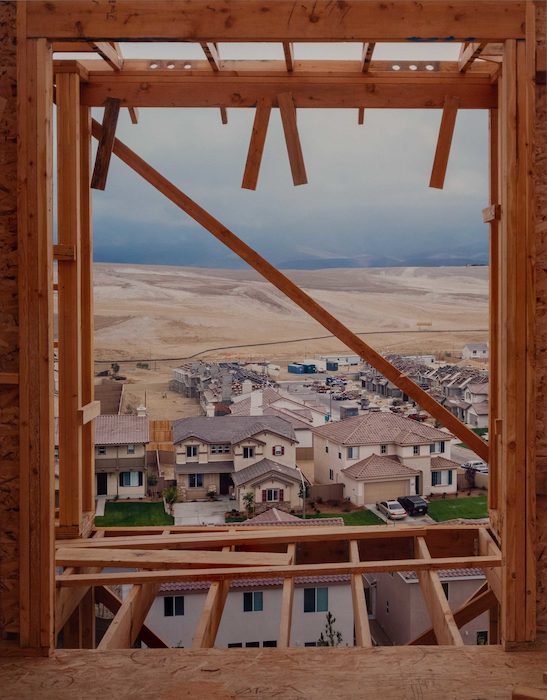
Stéphane Couturier, Fenetre, Eastlake Greens, San Diego, edition 4/8, 2001, dye coupler print, 130.81 x 107.95 x 2.54 cm (Los Angeles County Museum of Art, © Stéphane Couturier)
Stéphane Couturier, Fenetre, Eastlake Greens, San Diego, edition 4/8, 2001, dye coupler print, 130.81 x 107.95 x 2.54 cm (Los Angeles County Museum of Art, © Stéphane Couturier)
But the window in Couturier’s photograph is different, it makes clear that the space the viewer stands within is the second story of an unfinished building. The vista we have is likewise different. Rather than look out at a balcony, some potted plants and several sailboats in a harbor as we do in Matisse’s masterpiece, here lumber and plywood frame homes in various state of completion, and further back, an austere landscape on the outskirts of San Diego.
The homes closest to us—those visible through and just above the exposed floor upon which we stand—appear to be completed and occupied. The yards have been landscaped, cars park in the driveway, some shutters have been opened while others remain closed, and families are, no doubt, present. Just beyond those three homes are many others structures that are clearly not yet finished. Pickup trucks belonging to construction workers line the streets, still-wrapped shingles rest atop unfinished roofs, scaffolding can be seen, and office trailers provide respite from the unrelenting San Diego sun.
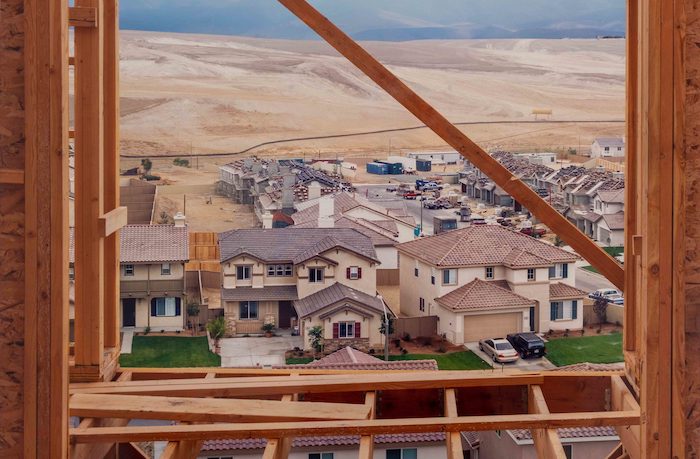
Stéphane Couturier, Fenetre, Eastlake Greens, San Diego (detail), edition 4/8, 2001, dye coupler print, 130.81 x 107.95 x 2.54 cm (Los Angeles County Museum of Art, © Stéphane Couturier)
Stéphane Couturier, Fenetre, Eastlake Greens, San Diego (detail), edition 4/8, 2001, dye coupler print, 130.81 x 107.95 x 2.54 cm (Los Angeles County Museum of Art, © Stéphane Couturier)
To view the photograph from the bottom to the top, then, we can see a progression from the homes that have been completed to those which eventually will be. But beyond those homes under construction, we can see the seemingly endless landscape that surrounds San Diego. If we were to reference what is perhaps the most famous landscape in the history of American art—Thomas Cole’s 1833 painting The Oxbow—we might gain further insight as to Couturier’s goals and intentions in Fenetre, Eastlake Greens, San Diego. In The Oxbow, humankind has cultivated and tamed the right (eastern) side of the painting; homes have been built, fields have been cleared, farms have been planted. The untamed wilderness remains on the western (left) side of the painting, but there is a sense of the inevitability of the human movement westward. Manifest Destiny is underway. This same sense of certainty is evident in Couturier’s photograph. Although there is a proverbially line in the sand—a junction where the buildings end and the landscape starts — we know this line is temporary. A view out of this same window today would show many more homes and less open land.
That line in the sand has been in constant flux since the arrival of Europeans in North America centuries ago. As the nineteenth century progressed, artists took particular interest in painting the vastness and beauty of this continent. The works these artists completed showed the American landscape with a kind of religious reverence. In the transition from the nineteenth to the twentieth century, people found themselves moving from the rural American farmland to increasingly modern urban centers. With this shift, artists then turned their attention to the bursting cities; bright, noisy, and energetic. They were also ever growing, and as the twentieth century grew into the twenty-first, the land that had once seemed endless, was rapidly consumed by the sprawl of humanity. Manifest Destiny had been achieved. The frontier had closed.
 Knowt
Knowt
